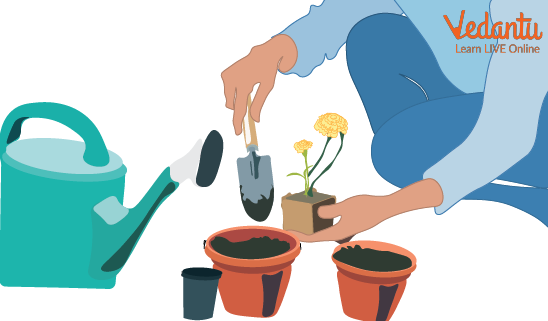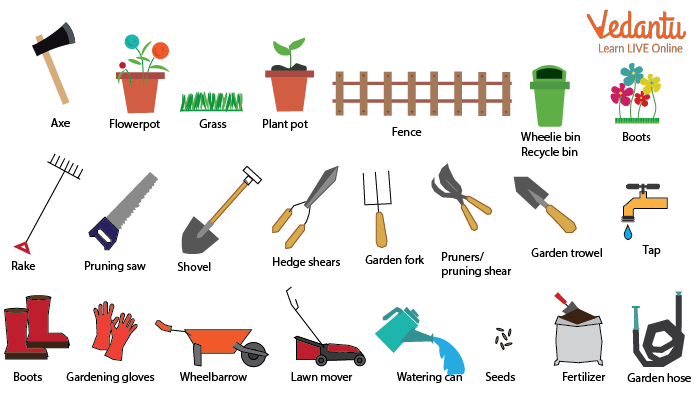




Common Garden Tools, Plants, and Objects Explained
Many people enjoy spending time in their gardens, whether for gardening, relaxing, or playing, and this is a topic of conversation that is likely to come up frequently when speaking English. Not only that, but knowing how to refer to garden items will help you when watching TV, reading, or browsing the internet in English, as there are many garden-related items in the media. The different gardening terms are fence, soil, grass, bucket, pipes, seeds, gravels, rake, flowers, animals, trees, hedge, fertilizers, garden trowel, pruning saw, gloves, pots, etc,.
Garden Vocabulary
A garden is a plot of land adjacent to a house that contains flowers, grass, and other plants, as well as a seating area. It's probably true that growing fruits, vegetables, and flowers in your garden can bring you joy and satisfaction, but you'd better be fluent in English to talk about it!

Things in The Garden
Gardening Terms
Hedge, Tree, Cow, Sheep, Fence, Plant, Wheelie bin (U.K)/ Recycling bin (U.S.), Pot, Bucket, Watering can, Garden hose, Boots, Broom, Fertilizer, Soil, Hoe, Gloves, Shovel, Wheelbarrow, Vegetable garden, Seed packet, Animal, Grass, Lawnmower, Flower, Pond, Faucet, etc,.

The Garden Vocabulary
Vocabulary for "Gardening Tools"
Gardening is the activity of cultivating and tending to a garden. An amateur or professional gardener performs this work. Gardening tools are objects used to help with gardening. Garden tools can be both hand and power tools.
Gardening Equipment
Rake: A rake is a long-handled tool with a row of teeth at the end that is used to collect leaves or loosen or smooth soil.
Pruning Shears: garden scissors with strong blades used to cut plants
A Hoe: A hoe is a tool with a long handle and a thin metal blade that is commonly used in gardening to break up dirt or make rows.
A Hose: A hose is a flexible pipe that is used to water a garden or lawn.
Lawn Mower: A lawn mower is a machine that is pushed over the grass to cut it. It can be electric, gas, or man-powered.
A Shovel: A shovel is a tool with a handle and a broad scoop or blade that is used for digging and moving material in the garden.
Spade: a tool similar to a shovel, with a handle and a broad scoop or blade used for digging; a spade is a smaller and more portable than a shovel.
Trowel: A trowel is a small hand tool with a handle and a flat metal blade that is used to scoop or spread dirt.
A Watering Can: A watering can is a metal or plastic container with a long spout and a nozzle that is used to water plants by hand.
Wheelbarrow: a one or two-wheeled cart with back handles used to transport small loads that are difficult or too heavy to carry by hand.
Verbs for Gardening
Here are some garden verbs that are frequently used: hoe, mix, mulch, pick, plant, plow, rake, sell, shovel, sort, sow, spray, thin, tie, transplant, water, cover, fertilize, gather.
Summary
A garden is a space outside a home where grass, flowers, trees, and other plants can be found. Some people enjoy growing flowers or other plants in their private gardens as a hobby or recreational activity. For landscaping, some gardens have ponds, pathways, or fountains. Gardening is the act of watering plants and caring for a garden.
FAQs on Garden Vocabulary for Students
1. What is gardening?
The job or activity of working in a garden, growing and caring for plants, and keeping it looking nice: My mother has always been interested in gardening. gloves for gardening Contrast. horticulture. Gardening is the horticultural practice of growing and cultivating plants. Ornamental plants are frequently grown in gardens for their flowers, foliage, or overall appearance; useful plants, such as root vegetables, leaf vegetables, fruits, and herbs, are grown for consumption, use as dyes, or medicinal or cosmetic purposes.
2. What are the different kinds of gardening?
There are several types of gardens, including the following:
Butterfly Parks: Plant butterfly-friendly flowers.
Gardening in Containers: Plants can be grown in containers if space is limited.
Gardens of Experimentation: These Extension gardens highlight native plants and environmentally friendly gardening techniques.
Herbs, Fruits, and Vegetables: When you grow your own edibles, they taste even better.
Gardening Organically: Composting, recycling yard waste, and using natural fertilizers and pesticides are all examples of green practices.
Aquatic Gardens: Discover the benefits of backyard ponds and aquascaping.
3. What does a garden represent?
A garden is a planned outdoor space dedicated to the cultivation, display, and enjoyment of plants and other forms of nature. The term "garden" is most commonly associated with the Garden of Eden. Gardens are typically an earthly paradise created by God to provide a safe haven. In Christian tradition, they represent the Virgin Mary. Gardens are also thought to represent the soul and innocence. It also represents consciousness due to its enclosed nature, as opposed to the forest. Gardens are commonly associated with femininity and fertility. Finally, these locations represent happiness, salvation, and purity.









